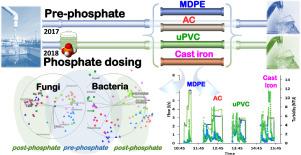Water Research ( IF 12.8 ) Pub Date : 2020-09-23 , DOI: 10.1016/j.watres.2020.116416 I. Douterelo , B.E. Dutilh , C. Calero , E. Rosales , K. Martin , S. Husband

|
Phosphate is routinely dosed to ensure regulatory compliance for lead in drinking water distribution systems. Little is known about the impact of the phosphate dose on the microbial ecology in these systems and in particular the endemic biofilms. Disturbance of the biofilms and embedded material in distribution can cause regulatory failures for turbidity and metals. To investigate the impact of phosphate on developing biofilms, pipe wall material from four independent pipe sections was mobilised and collected using two twin-flushing operations a year apart in a chlorinated UK network pre- and post-phosphate dosing. Intensive monitoring was undertaken, including turbidity and water physico-chemistry, traditional microbial culture-based indicators, and microbial community structure via sequencing the 16S rRNA gene for bacteria and the ITS2 gene for fungi. Whole metagenome sequencing was used to study shifts in functional characteristics following the addition of phosphate.
As an operational consequence, turbidity responses from the phosphate-enriched water were increased, particularly from cast iron pipes. Differences in the taxonomic composition of both bacteria and fungi were also observed, emphasising a community shift towards microorganisms able to use or metabolise phosphate. Phosphate increased the relative abundance of bacteria such as Pseudomonas, Paenibacillus, Massilia, Acinetobacter and the fungi Cadophora, Rhizophagus and Eupenicillium. Whole metagenome sequencing showed with phosphate a favouring of sequences related to Gram-negative bacterium type cell wall function, virions and thylakoids, but a reduction in the number of sequences associated to vitamin binding, methanogenesis and toxin biosynthesis. With current faecal indicator tests only providing risk detection in bulk water samples, this work improves understanding of how network changes effect microbial ecology and highlights the potential for new approaches to inform future monitoring or control strategies to protect drinking water quality.
中文翻译:

磷酸盐剂量对饮用水分配系统微生物生态学的影响:氯化网络中的实地研究
定期添加磷酸盐以确保饮用水分配系统中铅的法规遵从性。关于磷酸盐剂量对这些系统,特别是地方性生物膜中微生物生态的影响知之甚少。生物膜和包埋材料在分配过程中的扰动会导致浊度和金属的管理失灵。为了研究磷酸盐对正在发展的生物膜的影响,每年从四个独立的管段中收集并使用两个经过两次冲洗的管网材料,分别在加氯的英国网络中对磷酸盐进行磷酸盐前处理和后处理。进行了严格的监测,包括浊度和水的物理化学,基于传统微生物培养的指标,通过对细菌的16S rRNA基因和对真菌的ITS2基因测序来确定微生物群落结构。整个元基因组测序用于研究添加磷酸盐后功能特性的变化。
作为操作的结果,来自富含磷酸盐的水,特别是铸铁管的浊度响应增加了。还观察到细菌和真菌的生物分类组成上的差异,强调了社区向能够使用或代谢磷酸盐的微生物转移。磷酸盐增加了细菌的相对丰度,例如假单胞菌,杆状芽孢杆菌,马西利亚,不动杆菌和真菌Cadophora,根瘤菌和大戟属细菌。完整的基因组测序表明,与磷酸盐相关的序列与革兰氏阴性细菌类型的细胞壁功能,病毒体和类囊体有关,但与维生素结合,甲烷生成和毒素生物合成相关的序列数量却减少了。当前的粪便指标测试仅能提供大量水样本中的风险检测,这项工作可增进人们对网络变化如何影响微生物生态学的了解,并强调了采用新方法为将来的监测或控制策略提供保护饮用水质量的潜力。



























 京公网安备 11010802027423号
京公网安备 11010802027423号